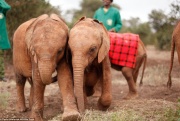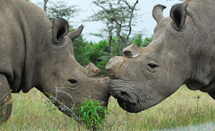African Wildlife Centres We Love
Discover a few of our favourite African Wildlife Conservation Centres, in this post.
Africa is filled with spectacular nature. From desert to rain forest, woodland to pointed mountain peaks, unspoilt beaches to vast savannahs, the diversity is incredible. Of course, this diversity also extends to the animals that call these habitats home – lanky giraffe, roaring lion, pre-historic-looking rhino, to name just three.
Just like in the rest of the world, the exponential growth of humanity and its accompanying industrial development and capitalist endeavours have led to devastating destruction of both habitats and animals, leaving many teetering on the edge of extinction.
Fortunately, there is an ever-growing concentration on the preservation of indigenous flora and the conservation of animals. It’s something that African Budget Safaris is passionate about, so many of our safaris visit wildlife centres that are at the forefront of conservation.
Moholoholo Rehabilitation Centre
 Moholoholo by Moholoholo Rehabilitation Centre
Moholoholo by Moholoholo Rehabilitation Centre
Established in 1991, the Moholoholo Wildlife Rehabilitation Centre cares for a variety of animals that are orphaned, injured or poisoned and in need of help. Situated near the Kruger National Park in the Limpopo Province in South Africa, Moholoholo is ideally placed to be involved in ‘problem animal’ control on farms in the area.
This is a very real conservation issue and just one aspect in which Moholoholo is involved. Animals removed from areas where they are unwanted – and in danger of being killed – are relocated into areas where they are welcome. Other projects include a successful serval breeding project and, of course, a wide array of rehabilitation – from vultures to rhino, and everything between.
Where possible, rehabilitated animals are released back into the wild, but some have stayed at the wildlife centre as they’d not survive in the wild. Whoever’s there at the time, you’re sure to meet some wonderful characters, like Stoffel, the honey badger Houdini.
Moholoholo conducts two guided tours per day, each one lasting two to two-and-a-half hours, during which you’ll be taught about all things conservation and see a wide range of wild African animals, close-up.
Khama Rhino Sanctuary
Khama Rhino Sanctuary, which covers over 8 000 hectares of Kalahari Sandveld in southern Botswana, was established in 1992. Their aim is to promote the conservation – and ensure the survival – of the highly endangered white and black rhino.
The long-term plan is to reintroduce these wonderful creatures into their natural wild habitat after safely breeding them within the sanctuary’s borders. Anti-poaching rangers and the Botswana Defence Force protect these precious rhinos. From a founder population of four rhinos, over fifteen have already been relocated.
The sanctuary also runs education programmes that promote awareness and knowledge in areas of conservation and environmentalism to the community at large and the park offers game drives and rhino tracking amongst other activities.
See our budget safaris to Khama Rhino Sanctuary.
David Sheldrick Wildlife Trust
The David Sheldrick Wildlife Trust, based in Nairobi, Kenya, is the world’s most successful orphaned elephant rescue and rehabilitation centre. Established in 1977 by his wife, Daphne, in honour of her husband, well-known naturalist, David Sheldrick, the trust has successfully hand-raised over 150 infant elephants and reintegrated them into the wild herds of Tsavo.
Their mission is clear: to conserve, preserve and protect wildlife. Measures include anti-poaching; safeguarding the natural environment; enhancing community awareness; addressing animal welfare issues; providing veterinary assistance to animals in need; and rescuing and hand rearing elephant and rhino orphans, along with other species that can ultimately enjoy a quality of life in wild terms when grown.
The elephant nursery, located in Nairobi National Park, is open daily for an hour between noon and 1 PM, when the little elephants are fed and enjoy a mud bath.
Giraffe Centre
Just 5 km out of Nairobi, is the Giraffe Centre, formally known as the African Fund for Endangered Wildlife. In operation since 1983, the centre promotes sustainable environmental conservation through education of the youth in Kenya.
Jock Leslie-Melvile and his wife Betty founded the fund in 1979 after Betty discovered that only 120 Rothschild giraffes were left on a small ranch in Western Kenya. Nairobi itself had grown, resulting in the devastation of the natural forest, but the sanctuary has preserved a tract of land which allows the giraffe to thrive in their natural habitat.
The wildlife centre is open for visitors daily from 9 AM to 5 PM
Namib Conservation Centre
A partnership between N/a’an ku se Foundation and Solitaire Guest Farm Desert Ranch, the Namib Carnivore Conservation Centre aims to solve the conflict between humans and the indigenous wildlife of the area, in order to preserve cheetahs, leopard and hyena.
The project, which started in 2008, promotes rehabilitation and reintroduction of large carnivores back into the wild in Namibia; studying and monitoring the carnivores to better protect them, and education and support to decrease human-wildlife conflict and education.
Painted Dog Conservation Centre
African Wild Dogs, colloquially referred to as Painted Dogs due to their beautiful colouring, are highly endangered. The Painted Dog Conservation Centre are doing their utmost to protect them and boost populations. Based in Zimbabwe, the project was started by Gregory Rasmussen in 1992.
Painted Dogs have a tough time of it, with snares, shooting and road kills accounting for 95% of mortalities. Added to that, the spread of domestic canine diseases, such as rabies, can knock out an entire pack. The programme’s mission is to educate and involve the community, protect habitat and the animals (anti-poaching), and rehabilitate and reintroduce dogs into the wild.
The Visitor’s Centre, located opposite Hwange Airport is a fascinating look into the plight of these beautiful dogs, their survival and the project. An interpretive walkway and trail through the enclosures allows visitors to see the dogs who are currently at the rehabilitation facility.
To find safari tours that visit these African Wildlife Centres and other conservation organisations speak to one of our knowledgeable Africa travel experts.
If you liked this post, these trips cover similar ground…
- Victoria Falls & Hwange Lodge - Zimbabwe Safari
- 6 Day Kruger Park Budget Safari (Backpackers Lodge Tour)
- Botswana Wildlife, Delta & Vic Falls Exclusive Budget Safari
- Serengeti & Zanzibar to Victoria Falls Safari Adventure
- East African Safari in Kenya & Tanzania (Lodge Safari)







 Briony is a qualified pharmacist, published author and travel blogger living in Cape Town. She writes her own blog about travel, the arts, music and the good things in life, with a focus on accessibility. She likes watching the world go by, and sometimes it makes her nose twitchy, but mostly it provides golden nuggets with which to light up the page.
Briony is a qualified pharmacist, published author and travel blogger living in Cape Town. She writes her own blog about travel, the arts, music and the good things in life, with a focus on accessibility. She likes watching the world go by, and sometimes it makes her nose twitchy, but mostly it provides golden nuggets with which to light up the page.











